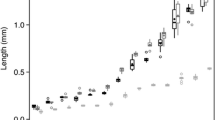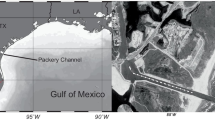Abstract
Aquatic insects undergo substantial shifts in their ecology during development, such as changing from a benthic consumer stage (e.g., larva) to a pelagic non-consumer stage (e.g., non-feeding pupae). Fish may differentially target these life-stages during predation, but the prevalence of this feeding is largely unknown. To determine how stage-specific feeding varies among fish species, we sampled fish diets from four freshwater habitats in southeastern South Dakota, USA. We measured the fraction of gut contents in fish that consisted of prey that do not feed in the aquatic food web (e.g., terrestrial insects or non-consumer stages of aquatic insects). We also compared estimates of dietary overlap using methods that either included or did not include prey life-stage information. When averaged across 22 fish species, 17% (10 to 25%) of diet dry mass consisted of prey that were not consumers in the aquatic food web. Non-consumer prey came from a mix of terrestrial subsidies (11%) and non-feeding life-stages of aquatic prey (6%). The overall fraction of non-consumer prey varied widely among fish species, from ~ 2% in a darter (Etheostoma nigrum) to ~ 52% in a minnow (Notropis stramineus). Adding prey life-stage information to estimates of dietary overlap revealed the presence of prey life-stage specialists and generalists in the fish populations, causing overlap to decline. The magnitude of this decline increased as individual fish ate more non-larval stages of aquatic insects. These results reveal the importance of considering developmental changes in prey when estimating fish diets and indicate that stage-structured prey partitioning reduces dietary overlap.




Similar content being viewed by others
Data availability
All supporting data and R script for analysis can be found at: https://github.com/Abrahamkanz/stageguildms.
Code availability
All supporting data and R script for analysis can be found at: https://github.com/Abrahamkanz/stageguildms.
References
Atlas WI, Palen WJ, Courcelles DM et al (2013) Dependence of stream predators on terrestrial prey fluxes: food web responses to subsidized predation. Ecosphere 4:1–16
Baxter CV, Fausch KD, Murakami M, Chapman PL (2004) Fish invasion restructures stream and forest food webs by interrupting reciprocal prey subsidies. Ecology 85:2656–2663
Baxter CV, Fausch KD, Carl Saunders W (2005) Tangled webs: reciprocal flows of invertebrate prey link streams and riparian zones. Freshw Biol 50:201–220
Benke AC, Huryn AD, Smock LA, Wallace JB (1999) Length-mass relationships for freshwater macroinvertebrates in North America with particular reference to the southeastern United States. J N Am Benthol Soc 18:308–343
Bolnick D, Paull J (2009) Morphological and dietary differences between individuals are weakly but positively correlated within a population of threespine stickleback. Evol Ecol Res 11:1217–1233
Bürkner P-C (2017) brms: an R package for Bayesian multilevel models using Stan. J Stat Softw 80:1–28
Burress ED, Holcomb JM, Bonato KO, Armbruster JW (2016) Body size is negatively correlated with trophic position among cyprinids. Royal Soc Open Sci 3:150652
Cable LE (1928) Food of bullheads. Bureau of Fisheries (No. 1037). US Government Printing Office, Washington, DC
Clegg T, Ali M, Beckerman AP (2018) The impact of intraspecific variation on food web structure. Ecology 99:2712–2720
Dahl J, Greenberg L (1996) Impact on stream benthic prey by benthic vs drift feeding predators: a meta-analysis. Oikos 77:177–181
Darwall WR, Freyhof J (2016) Lost fishes, who is counting? The extent of the threat to freshwater fish biodiversity. In: Closs GP, Krkosek M, Olden JD (eds) Conservation of freshwater fishes. Cambridge University Press, Cambridge, pp 1–32
De Roos AM, Schellekens T, Van Kooten T, Persson L (2008) Stage-specific predator species help each other to persist while competing for a single prey. Proc Natl Acad Sci 105:13930–13935
Gabry J, Simpson D, Vehtari A et al (2019) Visualization in Bayesian workflow. J R Stat Soc A 182:389–402. https://doi.org/10.1111/rssa.12378
Garman GC (1991) Use of terrestrial arthropod prey by a stream-dwelling cyprinid fish. Environ Biol Fishes 30:325–331
Gilinsky E (1984) The role of fish predation and spatial heterogeneity in determining benthic community structure. Ecology 65:455–468
Gillen AL, Hart T (1980) Feeding interrelationships between the sand shiner and the striped shiner. Ohio Academy Sci 80:71–80
Hargrave C (2009) Effects of fish species richness and assemblage composition on stream ecosystem function. Ecol Freshw Fish 18:24–32
Huang L, Bradshaw K, Grosskleg J, Siciliano SD (2019) Assessing space, time, and remediation contribution to soil pollutant variation near the detection limit using hurdle models to account for a large proportion of nondetectable results. Environ Sci Technol 53:6824–6833
Jelks HL, Walsh SJ, Burkhead NM et al (2008) Conservation status of imperiled North American freshwater and diadromous fishes. Fisheries 33:372–407
Kamler JF, Pope KL (2001) Nonlethal methods of examining fish stomach contents. Rev Fish Sci 9:1–11
Kraus JM, Pomeranz JF, Todd AS et al (2016) Aquatic pollution increases use of terrestrial prey subsidies by stream fish. J Appl Ecol 53:44–53
Matthews WJ (1998) Patterns in freshwater fish ecology. Chapman & Hall, New York
Matthews WJ, Shepard WD, Hill LG (1978) Aspects of the ecology of the duskystripe shiner, Notropis pilsbryi (Cypriniformes, Cyprinidae), in an Ozark Stream. Am Midl Nat 100:247. https://doi.org/10.2307/2424799
Merritt RW, Cummins KW, Berg M (2008) An introduction to the aquatic insects of North America. 4th Edn, Kendall Hunt Publishing, Dubuque
Miller TE, Rudolf VH (2011) Thinking inside the box: community-level consequences of stage-structured populations. Trends Ecol Evol 26:457–466
Nakano S, Miyasaka H, Kuhara N (1999) Terrestrial–aquatic linkages: riparian arthropod inputs alter trophic cascades in a stream food web. Ecology 80:2435–2441
Nilsson KA, Caskenette AL, Guill C, Hartvig M, Soudijn FH (2017) Including the life cycle in food webs. In: Moore JC, de Ruiter PC, McCann KS, Wolters V (eds) Adaptive food webs: stability and transitions of real and model ecosystems. Cambridge University Press, New York, pp 121–145
Nonaka E, Kuparinen A (2021) A modified niche model for generating food webs with stage-structured consumers: the stabilizing effects of life-history stages on complex food webs. Ecol Evol 11:4101–4125
Oliver DR (1971) Life history of the Chironomidae. Annu Rev Entomol 16:211–230. https://doi.org/10.1146/annurev.en.16.010171.001235
Pinder LCV (1986) Biology of freshwater Chironomidae. Annu Rev Entomol 31:1–23. https://doi.org/10.1146/annurev.en.31.010186.000245
Power ME, Parker MS, Dietrich WE (2008) Seasonal reassembly of a river food web: floods, droughts, and impacts of fish. Ecol Monogr 78:263–282. https://doi.org/10.1890/06-0902.1
Pusey BJ, Arthington AH (2003) Importance of the riparian zone to the conservation and management of freshwater fish: a review. Mar Freshw Res 54:1–16
R Core Team (2021) R: a language and environment for statistical computing. R Foundation Statistical Computing, Vienna
Rasmussen JB (1985) Effects of density and microdetritus enrichment on the growth of chironomid larvae in a small pond. Can J Fish Aquat Sci 42:1418–1422
Ross ST (2013) Ecology of North American Freshwater Fishes. University of California Press, Berkeley
Stan Development Team (2020) RStan: the R interface to Stan. R package Version 2.21.2. https://CRAN.R-project.org/package=rstan
Sullivan SMP, Manning DWP (2019) Aquatic–terrestrial linkages as complex systems: Insights and advances from network models. Freshwater Sci 38:936–945. https://doi.org/10.1086/706071
Sullivan S, Watzin M (2010) Towards a functional understanding of the effects of sediment aggradation on stream fish condition. River Res Appl 26:1298–1314
Sullivan ML, Zhang Y, Bonner TH (2012) Terrestrial subsidies in the diets of stream fishes of the USA: comparisons among taxa and morphology. Mar Freshw Res 63:409–414
Vanni MJ (2010) Preface: when and where do fish have strong effects on stream ecosystem processes? In Gido KB, Jackson DA (eds) Community Ecology of Stream Fishes: Concepts, Approaches, and Techniques. American Fishereis Society, Symposium 73, Bethesda, pp 531–538
Wagner A, Volkmann S, Dettinger-Klemm P (2012) Benthic–pelagic coupling in lake ecosystems: the key role of chironomid pupae as prey of pelagic fish. Ecosphere 3:1–17
Warmbold J (2016) Effects of fish on aquatic and terrestrial ecosystems. University of South Dakota, Thesis
Warmbold JW, Wesner JS (2018) Predator foraging strategy mediates the effects of predators on local and emigrating prey. Oikos 127:579–589
Werner EE, Gilliam JF (1984) The ontogenetic niche and species interactions in size-structured populations. Annu Rev Ecol Syst 15:393–425
Wesner JS (2010) Aquatic predation alters a terrestrial prey subsidy. Ecology 91:1435–1444
Wesner JS (2016) Contrasting effects of fish predation on benthic versus emerging prey: a meta-analysis. Oecologia 180:1205–1211
Wesner J (2019) Using stage-structured food webs to assess the effects of contaminants and predators on aquatic–terrestrial linkages. Freshwater Sci 38:928–935
Wesner JS, Pomeranz JP (2021) Choosing priors in Bayesian ecological models by simulating from the prior predictive distribution. Ecosphere 12:e03739
Wesner JS, Swanson DL, Dixon MD et al (2020) Loss of potential aquatic-terrestrial subsidies along the Missouri River floodplain. Ecosystems 23:111–123
Wesner J, Seidel T (2020) Stage-structured predation regulates a cross-ecosystem resource subsidy. Authorea. https://doi.org/10.22541/au.158273404.46491924
Wipfli MS (1997) Terrestrial invertebrates as salmonid prey and nitrogen sources in streams: contrasting old-growth and young-growth riparian forests in southeastern Alaska, USA. Can J Fish Aquat Sci 54:1259–1269
Zaccarelli N, Bolnick DI, Mancinelli G (2013) RInSp: an r package for the analysis of individual specialization in resource use. Methods Ecol Evol 4:1018–1023
Acknowledgements
We thank Alexis Culley, Katy McCarthy, Sarah Lane, Jacob Ridgway, and Justin Pomeranz for help in the field and the lab.
Funding
This study was funded by the National Science Foundation (#1837233 and #1560048), and by the University of South Dakota Graduate Research and Creativity Grant.
Author information
Authors and Affiliations
Corresponding author
Ethics declarations
Ethics approval
All procedures were approved by the Institutional Animal Care and Use Committee at the University of South Dakota (03–03-18-21C).
Competing interests
The authors declare no competing interests.
Additional information
Publisher's note
Springer Nature remains neutral with regard to jurisdictional claims in published maps and institutional affiliations.
Supplementary Information
Below is the link to the electronic supplementary material.
Rights and permissions
About this article
Cite this article
Kanz, A.J., Wesner, J.S. Stage-structured feeding by freshwater fish assemblages in eastern South Dakota, USA. Environ Biol Fish 105, 905–916 (2022). https://doi.org/10.1007/s10641-022-01296-8
Received:
Accepted:
Published:
Issue Date:
DOI: https://doi.org/10.1007/s10641-022-01296-8




